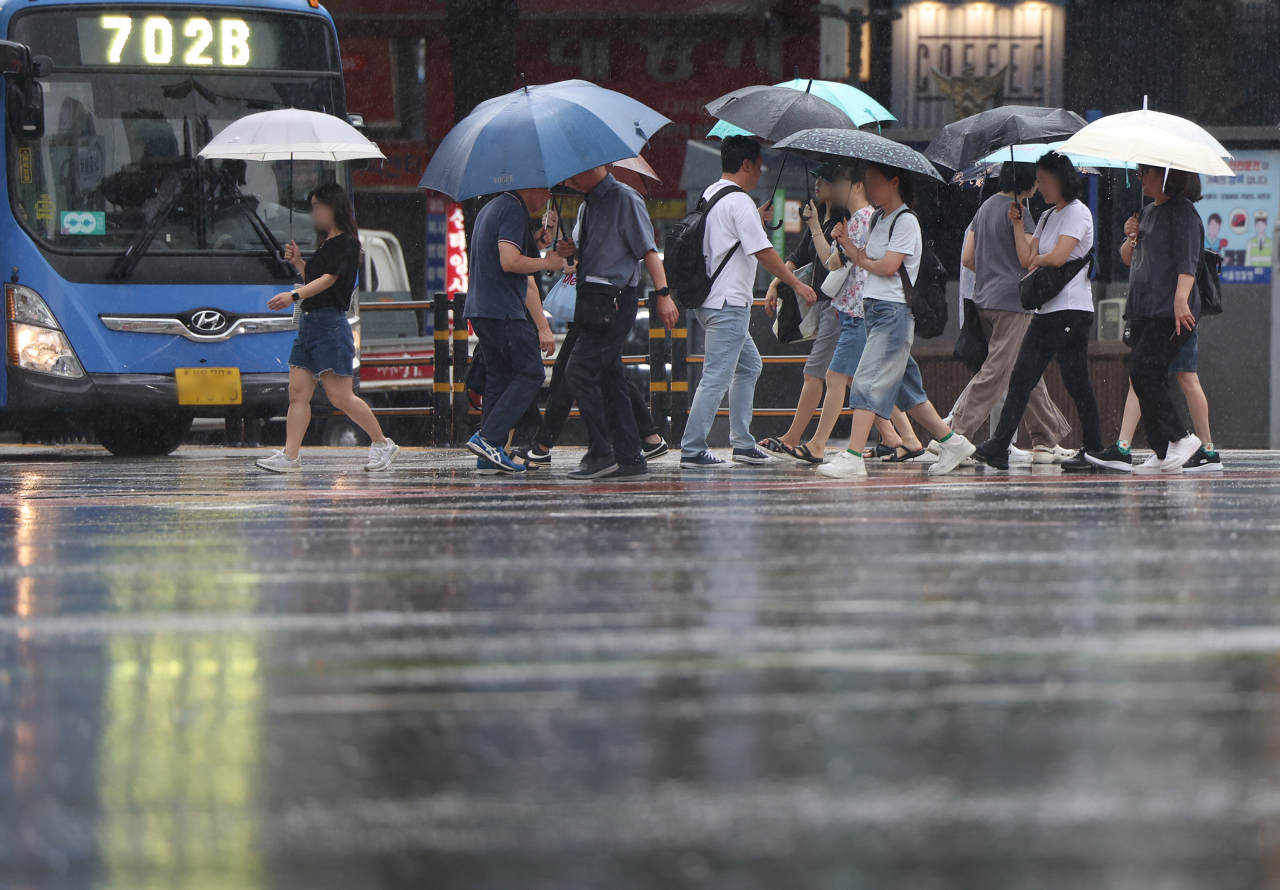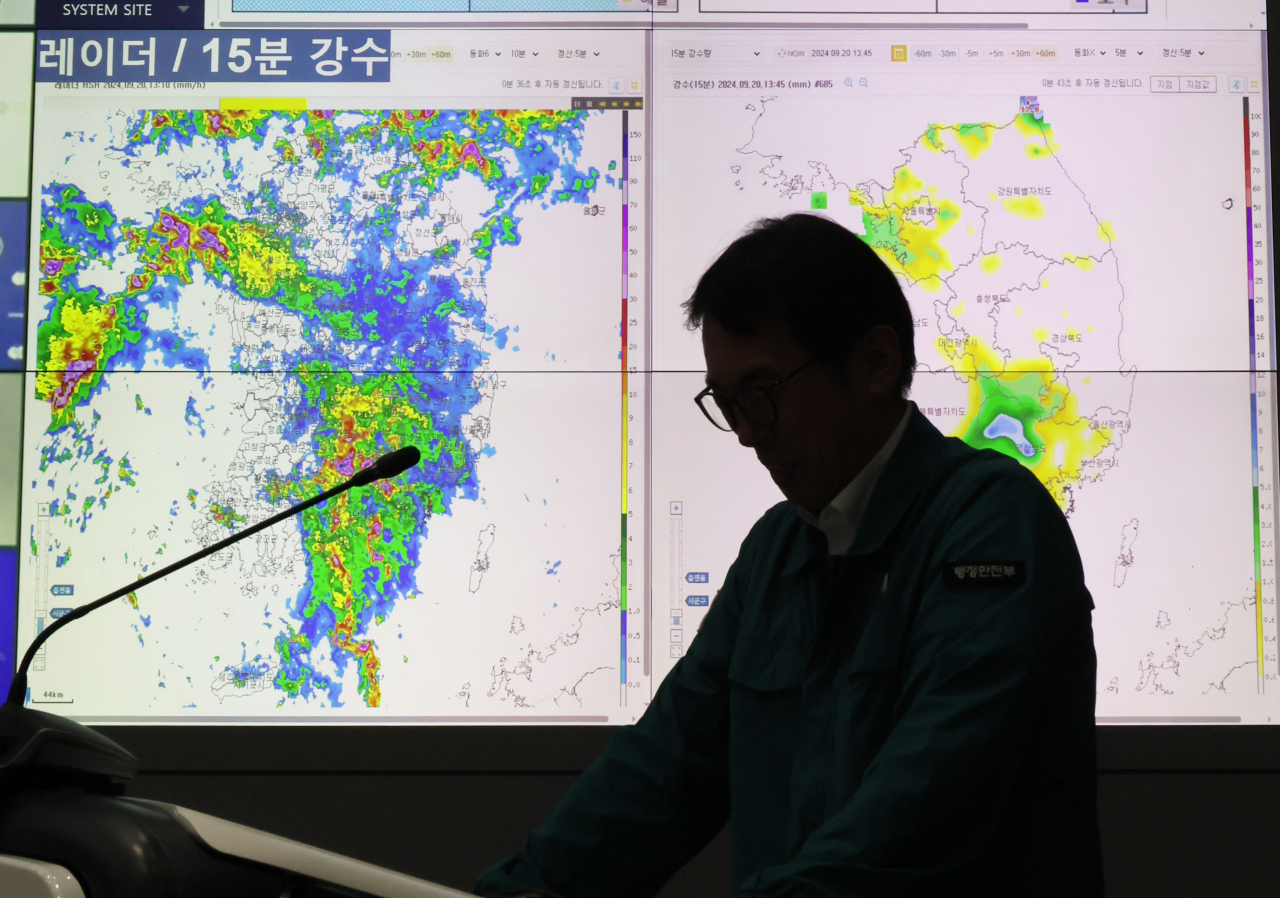 |
Pedestrians cross the street with umbrellas through the rain on Friday in Jung-gu, central Seoul as the city saw up to 16 millimeters of rain as of 4 p.m. (Yonhap) |
Heavy rain, with strong winds of up to 25 meters per second, is expected over the weekend when Typhoon Pulasan passes near South Korea’s southern region on Saturday evening, according to the Korea Meteorological Administration on Friday.
The state weather agency warned that heavy rain will be concentrated in the Greater Seoul area of Seoul, Incheon and Gyeonggi Province, the eastern coast of Gangwon Province, and Jeju Island, with some areas expected to receive up to 300 mm of rainfall by Sunday.
From Friday evening to Sunday, the central region, including Greater Seoul, Gangwon Province, and the Chungcheong Provinces, will experience rainfall rates of 30 to 50 mm per hour. Seoul, Incheon, northern Gyeonggi Province, and central and northern Gangwon Province could see up to 120 mm of rain, while the eastern coast and mountainous areas of Gangwon may receive 300 mm or more.
More than 200 mm of rain is predicted to fall on the southern coast of South Gyeongsang Province until Sunday, while Jeju Island will see rain of up to 150 mm, with heavily hit regions seeing up to 250 mm.
Along with heavy rain, the KMA anticipates strong winds ranging in speed from 20 to 25 meters per second until Saturday for Jeju Island and the southern coast of South Gyeongsang Province – strong enough to blow signboards off buildings. In the rest of the country, wind gusts of up to 15 meters per second are expected.
 |
The status of special advisories in effect and weather radar images are shown during a Central Disaster and Safety Countermeasure Headquarters meeting at Government Complex Seoul on Friday. (Yonhap) |
The Ministry of Interior and Safety activated a Level One emergency posture as of 9:30 a.m. Friday morning, the second level in its four-tier scale.
Interior Minister Lee Sang-min urged other concerned ministries to actively inspect and restrict access to underpasses and any other areas deemed vulnerable to landslides and to prioritize the safety of children, the elderly and people with disabilities.
Lee also ordered related agencies to use natural disaster texts, broadcasts and other communicative means to keep the public informed about heavy rain watches and access restrictions for certain areas.
“The government will put in every effort to minimize any casualties caused by heavy rain under the Central Disaster and Safety Countermeasure Headquarters,” said Lee on Friday.
Most parts of Korea have already seen heavy rain from Friday morning, with heavy rain watches issued in areas including Greater Seoul, Gangwon Province, South Jeolla Province and South Gyeongsang Province, as well as mountainous regions in Jeju Island and cities in the south including Busan and Ulsan.
As of 4 p.m. rainfall in Greater Seoul, Gangwon Province, South Jeolla Province and South Gyeongsang Province ranged between 20 and 50 mm per hour. Hallasan in Jeju Island also saw rainfall of up to 400 mm since Friday morning.
Typhoon Pulasan was originally expected to track deeper into inland China before turning east and passing south of Jeju Island. However, dry air over China disrupted its path, weakening it into a tropical depression now projected to pass between Jeju and Korea’s southern coast. This shift is expected to amplify the storm’s impact on Korea.
As the tropical depression approaches, it will clash with cold high-pressure winds, resulting in heavy rainfall, especially along the east coast and Jeju Island.
 |
Interior Minister Lee Sang-min speaks during the Central Disaster and Safety Countermeasure Headquarters meeting at Government Complex Seoul on Friday. (Yonhap) |







